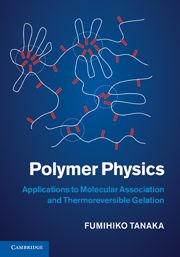Book contents
- Frontmatter
- Contents
- Preface
- 1 Statistical properties of polymer chains
- 2 Polymer solutions
- 3 Classical theory of gelation
- 4 Elasticity of polymer networks
- 5 Associating polymer solutions and thermoreversible gelation
- 6 Nongelling associating polymers
- 7 Thermoreversible gelation
- 8 Structure of polymer networks
- 9 Rheology of thermoreversible gels
- 10 Some important thermoreversible gels
- Index
- References
3 - Classical theory of gelation
Published online by Cambridge University Press: 16 May 2011
- Frontmatter
- Contents
- Preface
- 1 Statistical properties of polymer chains
- 2 Polymer solutions
- 3 Classical theory of gelation
- 4 Elasticity of polymer networks
- 5 Associating polymer solutions and thermoreversible gelation
- 6 Nongelling associating polymers
- 7 Thermoreversible gelation
- 8 Structure of polymer networks
- 9 Rheology of thermoreversible gels
- 10 Some important thermoreversible gels
- Index
- References
Summary
This chapter presents the definition of gels and gives some typical examples, followed by a description of their structures and fundamental properties. A statistical mechanical treatment of the chemical gels in the polycondensation reaction is developed to find the molecular weight distribution, average molecular weight, gel point, and the gel fraction.
What is a gel?
Definition of a gel
Gels are three-dimensional networks made up of molecules, polymers, particles, colloids, etc., that are connected with each other by the specific parts on them such as functional groups and associative groups. The connected parts are called cross-links. Gels usually contain many solvent molecules inside their networks, and hence they are close to liquid in composition, but show solid-like mechanical properties due to the existence of the cross-links [1–4].
Although this statement can be adopted as a formal definition of gels, there are many exceptional ones that do not fall neatly into this categorization. For instance, colloidal suspensions exhibit gel-like rheological behavior at high densities. Entanglements of long rigid fibrillar molecules or an assembly of molecules mutually hinder their motion, and lead to gel-like rheology due to jamming of the rigid segments. In such materials, there are no direct cross-links, but geometrical or topological constraints play similar roles to the cross-links, although they are delocalized. Therefore, to define gels by connectivity only is not sufficient to include these materials.
- Type
- Chapter
- Information
- Polymer PhysicsApplications to Molecular Association and Thermoreversible Gelation, pp. 97 - 127Publisher: Cambridge University PressPrint publication year: 2011
References
- 1
- Cited by

